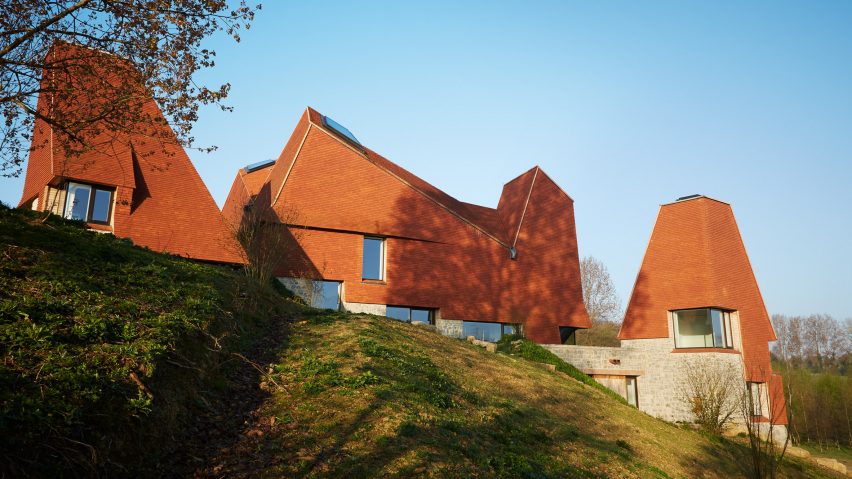Rooms topped with chimney-like roofs surround a secluded courtyard to from this house in Kent, England, which takes its angular form and russet colouring from the area's hop-drying oast towers.
British architect James Macdonald Wright of Macdonald Wright Architects worked with Niall Maxwell of Rural Office for Architecture on the design for Caring Wood house, which provides a residence for three generations of the same family.
Wright selected an 34-hectare plot of the Kent countryside, just a stone's throw from London.
The plot had been populated by agricultural polytunnels, but these were cleared away to make space for the house. The remainder was returned to woodland – one of the planning stipulations for the build.
Situated on the side of a small hill, the house appears as a group of small individual blocks defined by angular tile-covered roofs. The style of the roofs alludes to the area's traditional oast houses, which are used to dry hops in preparation for the brewing process.
This reference, alongside the planting of 25,000 native trees in the grounds, contributed to the project being granted planning permission under PPS7 – a planning document that makes it possible to build ambitious contemporary projects, on the grounds that they are "truly outstanding or innovative".
"Its brief was twofold: to embody the spirit of the English country house and estate in a design that would embrace its context and landscape," said the architects, "and to provide a sustainable home for life, both in the sense of carbon neutrality and in terms of a flexible design that can accommodate an entire family and evolve with them, potential being extended for future generations."
The seemingly disconnected blocks are in fact connected at their rag-stone bases, providing four separate yet linked spaces that represent the four units of the extended family. These are arranged like a pinwheel around a shared central courtyard.
Their roofs descend down to almost touch the ground. These are covered in 150,000 handmade peg tiles from Sussex, which are mounted on a cross-laminated timber structure.
While the house prioritises views out over the bucolic landscape of woods and meadows, this inner courtyard is intended as a space for contemplation. The aperture between the roofs draws the eye upward towards the sky or down to a pool of water.
Terracotta tiles pave the ground surrounding the reflective pool, while the walls and eaves are covered in light-toned wood panelling.
The plan is arranged to provide a mixture of family and entertaining space, with a room containing a grand piano designed to accommodate more than 50 guests for a recital, as well as viewings of the clients' art collection.
The interior is painted white throughout, bar its wooden floors, to emphasis the irregularities and height of the ceiling.
"The roofs find expression from the inside of the house as well, giving magnitude to the ceilings of even modest-sized bedrooms and creating natural opportunities for light wells," said the architects, "the largest of which illuminates a monumental staircase descending from Caring Wood's grand mezzanine area to the lower ground living quarters."
A small cottage with a matching oast-style roof and rag-stone walls just a short distance away from the main house and provides a home for the estate manager.
Both properties are designed to be use as little energy as possible, and for all CO2 emissions to be fully offset. A ground-source heat pump heats the house, while electricity is supposed by solar panels integrated into a bank. Rainwater is also harvested and reused on the site, and the courtyard in the main house provides passive cooling in summer.
The 25,000 native trees are also designed to do their bit by absorbing around 25,000 tonnes of carbon over the next 40 years.
The approach route to the house was carefully curated, with patches of woodland, meadow, wetland and hedgerow revealing and concealing views along different sections of the driveway.
"The fact that the house emerges from the hill also affects the way that it is seen on approach. In historic country house style, a sense of anticipation is created by providing a glimpse of the house and then restricting it," explained the architects.
"The final approach over the brow of the hill from the west and to the threshold allows the house to take control. It limits views and expresses its entrance."
The team worked with the Farming and Wildlife Advisory Group to develop the planting, which they hope will provide a habitat for at-risk wildlife displaced by deforestation of the site around a 100 years ago.
The woodland gives ways to more manicured gardens with areas of lawn, flower beds and vegetable patches further towards the house.
In 2012, architects Duggan Morris restored and extended an old oast house in the neighbouring county of Sussex, using roughly-sawn oak to clad a low-rise addition that emphasises rather than challenges the height of the building's roof.
Photography is by James Morris unless otherwise stated.
Project credits:
Architects: James Macdonald Wright and Niall Maxwell
Design and project managers: Macdonald Wright Architects
Executive architects: Rural Office for Architecture
Landscape and ecology consultant: Spacehub
Structural engineer: Price and Myers
Planning consultant: DHA Planning
Services engineer: Synergy Consulting Engineers
Ecological building consultant: Conker Conservation
Acoustic consultant: Neill Woodger Acoustics and Theatre Design
Groundworks project manager:Alex McLennan
Main contractor: Cardy Construction
Groundworks and structure: Hague Construction
Landscaping contractor: Landform Consultants

